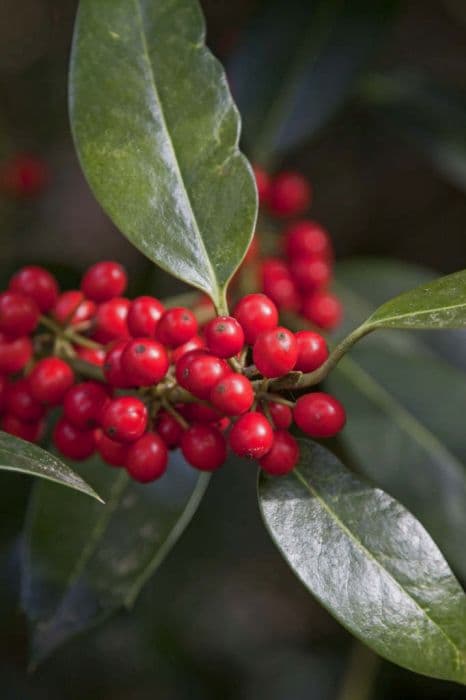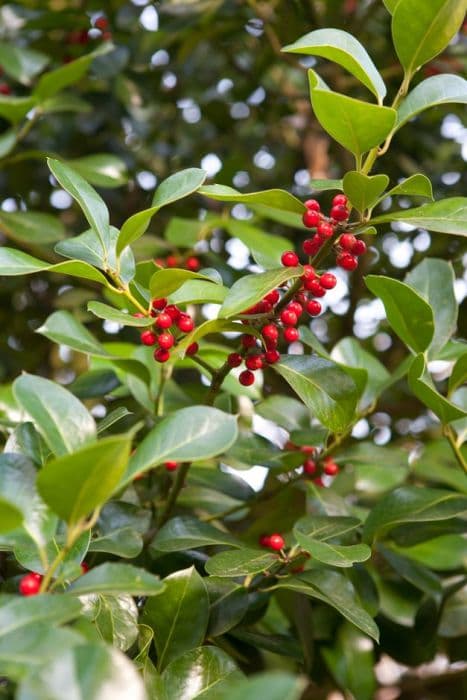Highclere holly Ilex × altaclerensis 'James G. Esson' (f)

ABOUT
The plant commonly referred to as 'James G. Esson' holly is a visually striking shrub characterized by its glossy variegated leaves and dense, bushy growth habit. The leaves display a unique pattern, combining deep green centers with yellow or creamy-white edges, giving the plant a bright and vibrant appearance. This contrast is particularly noticeable as the variegated leaves densely pack together to create a lush, textured look. During the growing season, 'James G. Esson' holly produces small flowers that may go unnoticed due to their size, but they play a crucial role in the plant's lifecycle. These flowers later give way to ornamental red berries, which are a signature trait of hollies and a feast for the eyes, especially in the colder months when the plant's foliage may take on a slightly different hue. The berries also provide a food source for birds, adding ecological value to the garden. Overall, the 'James G. Esson' holly has a rounded form and a well-branched structure that makes it an attractive standalone specimen or a compelling choice for a mixed border or hedge. Its evergreen nature ensures year-round interest and a constant splash of color in the landscape.
About this plant
 Names
NamesFamily
Aquifoliaceae
Synonyms
Highclere Holly
Common names
Ilex × altaclerensis 'James G. Esson'
 Toxicity
ToxicityTo humans
The Highclere holly is a plant with some degree of toxicity to humans. If ingested, the berries are known to cause symptoms such as nausea, vomiting, diarrhea, and abdominal pain. While the plant's leaves might not be as toxic as the berries, they can still cause stomach upset if eaten in large quantities. It is advisable for humans to avoid ingesting any part of this plant.
To pets
The Highclere holly is also toxic to pets, including both dogs and cats. The primary toxic components are the plant's berries which, if ingested, can lead to symptoms like vomiting, diarrhea, decreased appetite, and lethargy in pets. It's important to prevent pets from eating any part of the plant to avoid these potential health issues.
 Characteristics
CharacteristicsLife cycle
Perennials
Foliage type
Evergreen
Color of leaves
Variegated
Flower color
White
Height
8-10 feet (2.4-3 meters)
Spread
8-10 feet (2.4-3 meters)
Plant type
Shrub
Hardiness zones
6
Native area
Cultivar
Benefits
 General Benefits
General Benefits- Ornamental Appeal: Adds visual interest to gardens with its variegated leaves and pyramidal shape.
- Wildlife Attraction: The berries provide food for birds, contributing to biodiversity.
- Privacy and Screening: Can be used as a hedge or screen for privacy due to its dense growth habit.
- Low Maintenance: Requires minimal upkeep once established, making it suitable for busy gardeners.
- Hardiness: Tolerates a range of soil types and resists many common pests and diseases.
- Year-Round Interest: Offers evergreen foliage that remains attractive across seasons.
- Drought Tolerance: Once established, can withstand periods of dry weather without excessive watering.
- Versatility in Landscaping: Suitable for a variety of landscape designs, from formal to woodland gardens.
 Medical Properties
Medical PropertiesThis plant is not used for medical purposes.
 Air-purifying Qualities
Air-purifying QualitiesThis plant is not specifically known for air purifying qualities.
 Other Uses
Other Uses- Wildlife Shelter: Holly 'James G. Esson' provides dense foliage that can offer shelter and nesting opportunities for birds and small mammals.
- Topiary Art: With its sturdy and dense structure, Holly 'James G. Esson' can be pruned into various shapes for ornamental topiary gardens.
- Hedging Border: Often used for a formal appearance, the holly 'James G. Esson' can be trimmed to create a well-defined hedge border for properties.
- Erosion Control: The extensive root system of Holly 'James G. Esson' can help stabilize soil, reducing erosion on slopes and banks.
- Privacy Screens: Due to its evergreen nature, it can be planted in rows to create a year-round privacy screen for homes or gardens.
- Windbreaks: Its thick foliage can serve as a windbreak, protecting smaller plants and reducing wind damage in gardens.
- Winter Garden Interest: Its evergreen leaves and potential for bright berries can add color and interest to otherwise barren winter landscapes.
- Cultural Symbolism: The holly 'James G. Esson' can be used in traditional Christmas decorations as a symbol of the holiday season in many cultures.
- Photography Backdrop: Because of its attractive, dense green leaves, it can be used as a natural backdrop for outdoor photography.
- Sound Barrier: When planted in mass, Holly 'James G. Esson' can help dampen noise, acting as a natural sound barrier for properties near busy areas.
Interesting Facts
 Feng Shui
Feng ShuiThe Highclere holly is not used in Feng Shui practice.
 Zodiac Sign Compitability
Zodiac Sign CompitabilityThe Highclere holly is not used in astrology practice.
 Plant Symbolism
Plant Symbolism- Protection: Ilex, commonly known as holly, has been traditionally associated with protection. In folklore, it was believed to guard against evil spirits and negative energies.
- Good Fortune: Holly is often considered a symbol of good luck and prosperity, making it a common decorative plant during the Christmas season.
- Fertility: The robust growth and evergreen nature of holly symbolize continuous life and can be associated with fertility and eternal existence.
- Hope: With its capacity to survive in harsh conditions and remain evergreen throughout the year, holly represents hope and the endurance of life through difficult times.
 Water
WaterHighclere holly 'James G. Esson' prefers consistently moist soil, but it is also important to ensure that the soil is well-draining to prevent root rot. Water the plant deeply once a week, providing about 1 to 1.5 gallons per watering session, depending on the size of the plant and the weather conditions. During hot and dry periods, you may need to increase the frequency of watering to twice a week, carefully observing the moisture level of the soil. In winter, reduce watering to every other week or less, as the plant's water requirements decrease during dormancy.
 Light
LightHighclere holly 'James G. Esson' thrives best in full sun to partial shade. It is adaptable, but for the best growth and foliage density, a location with at least four to six hours of direct sunlight is ideal. Avoid placing it in deep shade, which can lead to sparse growth and reduced vigor.
 Temperature
TemperatureHighclere holly 'James G. Esson' is hardy in a range of temperatures but performs best when the temperature remains between 50°F and 80°F. It can tolerate brief periods of colder weather down to about 0°F and can withstand summer highs up to about 90°F. Make sure to protect the plant from extreme temperatures both high and low by providing proper mulching and situating it in a favorable location.
 Pruning
PruningHighclere holly 'James G. Esson' should be pruned to maintain its shape and promote bushier growth. The best time to prune is in late winter or early spring before new growth begins. Prune as needed to remove any damaged or diseased branches, and to encourage a dense growth habit. Pruning every year or every other year is usually sufficient to keep the plant looking its best.
 Cleaning
CleaningAs needed
 Soil
SoilHighclere Holly prefers well-drained soil with a mix of loam, peat, and sand to sustain root health. Aim for a soil pH of 5.0 to 6.0, which is slightly acidic.
 Repotting
RepottingHighclere Holly should be repotted every 3 to 5 years, or when root-bound.
 Humidity & Misting
Humidity & MistingHighclere Holly tolerates a wide range of humidity levels but thrives best if the humidity is moderate to high.
 Suitable locations
Suitable locationsIndoor
Place in bright, indirect light with some direct sun.
Outdoor
Plant in partial shade to full sun in a sheltered spot.
Hardiness zone
6-9 USDA
 Life cycle
Life cycleThe common name of Ilex × altaclerensis 'James G. Esson' is Highclere holly. It begins its life cycle as a seed, which, once germinated, develops into a small sapling. Through the juvenile stage, the sapling grows, forming a sturdy root system and branching out to become a young bush. As the plant matures, it develops the characteristic glossy, spiny-toothed evergreen leaves and may produce small white flowers if it finds suitable cross-pollination partners, as 'James G. Esson' is a female cultivar. Upon successful pollination, it bears bright red berries, which are attractive to wildlife and can aid in the dissemination of seeds. Throughout its lifespan, Highclere holly can experience multiple cycles of growth, flowering, and fruiting, typically reaching full maturity in 10-15 years, with the potential to live several decades if grown in favorable conditions.
 Propogation
PropogationPropogation time
Spring-Early Summer
Ilex × altaclerensis 'James G. Esson', commonly known as the Highclere holly, is best propagated through semi-hardwood cuttings. This method involves taking cuttings from the current year's growth in the late summer or early fall, when the wood is neither too soft nor too hard. The ideal cutting length is about 4 to 6 inches (10 to 15 centimeters), and it should include several leaves. It is important to create a clean cut and immediately place the cutting into a rooting hormone to enhance rooting success. The treated cutting should then be inserted into a well-draining potting mix, ensuring that at least two sets of leaves remain above the soil surface. The pot should be kept in a sheltered location with indirect sunlight and consistent moisture. Roots typically develop within several weeks to a few months, and once rooted, the new plants can be gradually acclimated to ambient conditions before planting out.









